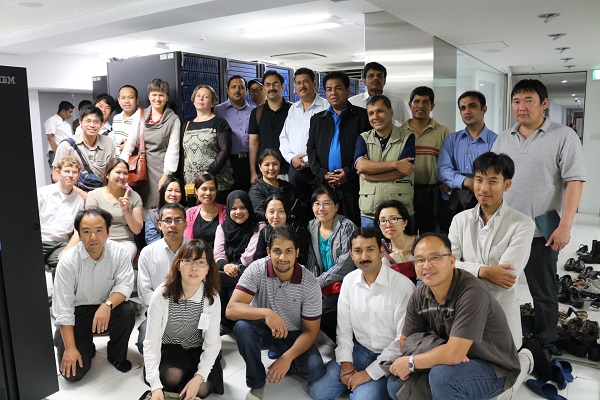The AWCI Training Course
on Improved Bias Correction and Downscaling Techniques for Climate Change Assessment including Drought Indices
Date: 18th -
20th June 2013
Venue: University of Tokyo Hongo Campus, Tokyo, Japan
Group Photos

The Training Course DAY1 Group Photo

The Visit of the DIAS Core System Group Photo
What's New
| ● Summary Participant Report available. | 9 September 2013 |
| ● Training Course Report available. | 8 July 2013 |
| ● Photos available. | 26 June 2013 |
| ● Presentation files available. | 26 June 2013 |
| ● Agenda finalized. | 14 June 2013 |
| ● Training Course website opened. | 17 May 2013 |
| ● Invitation letter released. | 25 April 2013 |
| ● First announcement released. | 16 April 2013 |
Announcement
We are pleased to announce that an AWCI Training Course on Improved Bias Correction and Downscaling Techniques for Climate Change Assessment including Drought Indices will be held at the University of Tokyo, Japan, 18 – 20 June 2013. The event has been proposed as a part of activities of the AWCI project "Impact of Climate Change on Glacier Melting and Water Cycle Variability in Asian River Basins" that is funded under the Asia-Pacific Network for Global Change Research (APN) CAPaBLE Programme and led by Dr. Ghulam Rasul, Pakistan Meteorological Department (PMD). The training course also contributes to the AWCI project "GEOSS/Asian Water Cycle Initiative/Water Cycle Integrator(GEOSS/AWCI/WCI)" funded under the APN ARCP Programme and led by Dr. Osamu Ochiai, Japan Aerospace Exploration Agency (JAXA). The local host and another sponsor of the event is the University of Tokyo (UT).
The training course will provide explanation of the improved techniques for climate change assessment including general circulation model (GCM) selection, model output (precipitation) bias correction, downscaling of the corrected output to a basin scale and generation of drought indices and drought assessment. The course includes two and a half day of lectures with hands-on exercises, during which the participants will use the data of their country demonstration basin. In the afternoon of the last day, an excursion to the DIAS core system at the Komaba campus is scheduled.
Objectives
- Capacity building. Participants will learn:
- Improved methods and tools necessary for processing climate model projections of future meteorological variables to be usable for assessment of climate change impacts on water resources,
- Application of the processed GCM output as forcing data to run WEB-DHM in their AWCI basin, and
- Generation of drought indices from the WEB-DHM output for historical and future periods.
- Preliminary Climate Change Impact Analysis in participating basins. The results obtained during the training course are expected to be usable for regional analysis of climate change impacts on water resources, in particular droughts.
Scope
- A method for selection relevant models out of the CMIP family of general circulation models (GCMs) and necessary tools (on-line).
- A comprehensive statistical method for bias correction of the GCM precipitation output (historical simulation and future projection) including heavy, normal and low rainfall events and using rain-gauge data provided for the AWCI CCAA study; necessary tools (on-line).
- A statistical spatial downscaling method using available rain-gauge data within the basin; necessary on-line tools; (option to use GSMaP data to obtain spatial distribution in case of very limited number of stations will be explained but not actually used).
- Running WEB-DHM using the bias corrected and downscaled precipitation data of one pre-selected GCM, other forcing data will also be extracted from this GCM (not bias-corrected). Only basins that participated in the March 2011 will be considered for this step, i.e. Meghna (Bangladesh), Punatsangchhu (Bhutan), Sangker (Cambodia), Citarum (Indonesia), Tone (Japan), Langat (Malaysia), Tuul (Mongolia), Shwegyin (Myanmar), Narayani (Nepal), Soan (Pakistan), Pampanga (Philippines), Kalu Ganga (Sri Lanka), Mae Wang (Thailand), Huong (Vietnam).
- A method to generate drought indices and drought assessment method and tools using corrected precipitation outputs for past and future AND simulated river discharge by WEB-DHM. The full method using further spatial hydrological outputs by WEB-DHM (groundwater, soil moisture, surface fluxes) will be explained but not actually used for the training (time limitation).
- In-situ data quality control tool.
